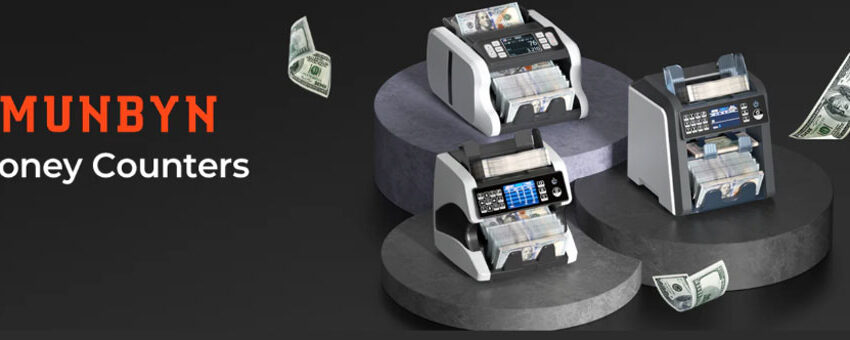Accuracy at Speed: Why Money Counting Machines Are Essential in Modern Cash Handling

Cash may not be as dominant as it once was, but for many industries and businesses, it still plays a crucial role in daily operations. Whether it’s a retail store, a bank, a casino, or a small business managing a busy point-of-sale counter, handling physical currency remains a reality. And when dealing with large volumes of cash, precision and time management become critical. This is where a MUNBYN money counter machine proves its worth.
Counting cash by hand may seem straightforward, but it’s surprisingly error-prone. Fatigue, distractions, and inconsistent counting speeds often lead to miscalculations. Multiply that across dozens or hundreds of transactions, and the potential for loss, both in time and money, becomes significant. That’s exactly why money counting machines have become standard tools across sectors that deal with regular cash flow.
What Is a Money Counting Machine?
A money counter machine is a device designed to accurately count large amounts of banknotes or coins. Depending on the model and features, it may also detect counterfeit bills, sort denominations, or even batch notes into specific quantities.
Basic machines focus on speed and accuracy, rapidly tallying stacks of bills far more efficiently than a human can. More advanced versions offer built-in counterfeit detection, automatic denomination recognition, and error alerts, making them essential tools not just for speed but also for security and compliance.
Where Are Money Counting Machines Used?
These MUNBYN money counter machines aren’t just found in banks anymore. They’re becoming more common in places like:
- Retail stores that deal with cash drawers at the end of the day
- Casinos and arcades that need to tally tokens, bills, or coins regularly
- Restaurants where multiple registers require end-of-day reconciliation
- Event organizers managing ticket sales and on-site purchases
- Nonprofits processing large cash donations after fundraisers
Even small businesses, like barbershops, local shops, or food trucks, can benefit from using a money counting machine to speed up daily closeouts and reduce discrepancies.
The Case for Automation in Cash Handling
Manually counting cash may feel traditional or even secure to some, but it comes with real drawbacks:
- Human error: A single miscount can throw off a cash drawer or deposit total.
- Time consumption: Counting, recounting, and verifying can take valuable minutes (or hours) away from other tasks.
- Security risks: Handling cash repeatedly in open areas can increase theft risk.
- Staff fatigue: Counting high volumes, especially during long shifts, increases error rates and delays.
Using a money counter machine removes these issues. It’s not just about convenience—it’s about confidence in your numbers.
Speed Meets Accuracy
One of the most obvious benefits of a money counting machine is speed. Some machines can process over 1,000 bills per minute—something no person can match with consistent accuracy.
But speed without accuracy is useless. These machines use sensors, rollers, and software to ensure each note is detected and counted correctly. If a bill is folded, stuck, or damaged, the machine usually alerts the user immediately, reducing the risk of mistakes or missed notes.
Counterfeit Detection: A Vital Safeguard
A growing number of money counter machines now include counterfeit detection features. These can include:
- Ultraviolet (UV) scanning: Detects fluorescent features on legitimate currency.
- Magnetic (MG) sensors: Identify magnetic ink used in authentic bills.
- Infrared (IR) analysis: Verifies paper density and hidden patterns.
- Size detection: Checks dimensions of each note for uniformity.
While no machine can catch every fake bill, they greatly reduce the odds of counterfeit notes slipping through unnoticed. This can protect businesses from unintentional fraud and financial loss.
Batch Counting and Sorting
Many businesses don’t just want to count—they need to prepare cash. This includes bundling certain amounts for deposits, tills, or secure transport. A money counting machine with batching functionality can be programmed to stop after counting, say, 100 or 200 bills, allowing users to stack consistent bundles quickly.
Some high-end machines even sort different denominations or currencies. This is especially useful for businesses that accept multiple types of bills or operate in tourist-heavy areas.
Cost vs. Value
There’s a misconception that money counting machines are only for large enterprises. In reality, many affordable models are available, especially for small to mid-sized businesses. When you factor in the time saved, errors avoided, and protection from counterfeits, the value quickly outweighs the cost.
For instance, imagine a staff member spends 30 minutes each day counting and reconciling cash. Over a month, that’s more than 10 hours—time that could be spent on customer service, planning, or sales. A money counter machine eliminates that recurring drain almost instantly.
Final Thoughts
In a digital world, handling physical cash might seem outdated to some, but it’s still a daily reality for millions of businesses. The smarter approach isn’t to avoid cash, but to manage it better. A money counting machine streamlines the process, improves accuracy, protects against fraud, and saves valuable time. Whether you’re counting a drawer, preparing deposits, or safeguarding against counterfeit bills, this compact device offers a reliable solution to a problem as old as money itself.





